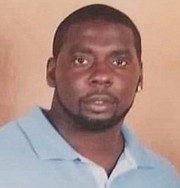Families want answers in latest police shootings in Va. and N.C.
Free Press wire reports | 4/29/2021, 6 p.m.

Families in North Carolina and Virginia are still demanding answers from law enforcement authorities following separate shootings by sheriff’s departments that left one man dead and another fighting for his life in intensive care.
A judge in Elizabeth City, N.C., refused Wednesday to release body camera video showing Pasquotank County sheriff’s deputies shooting and killing 42-year-old Andrew Brown Jr., ruling that making the video public at this stage could jeopardize the investigation into his death on April 21.
However, Judge Jeffery Foster ordered authorities to allow Mr. Brown’s family to privately view five videos from body cameras and one from a dashboard camera within 10 days, with some portions blurred or redacted.
Mr. Brown’s family previously had been allowed earlier this week to view only a 20-second clip from a single body camera.
Judge Foster said he believed the videos contained information that could harm the ongoing investigation or threaten the safety of people seen in the footage. He said the video must remain out of public view for at least 30 days, but he would consider releasing it after that point if investigations are complete.
“The release at this time would create a serious threat to the fair, impartial and orderly administration of justice,” Judge Foster said.
Mr. Brown, who was unarmed, was shot in a hail of gunfire by deputies serving drug-related search and arrest warrants outside his Elizabeth City home. Attorneys for the Brown family said Mr. Brown was sitting in his car with his hands on the steering wheel while he was being shot at, and then tried to back up and drive away to save his own life.
On Tuesday, Mr. Brown’s family released an independent autopsy showing he was shot five times, including four wounds to his arm and a fatal shot to the back of the head.
“Yesterday, I said he was ‘executed.’ This autopsy report shows me that was correct,” Mr. Brown’s son, Khalil Ferebee, told the media on Tuesday.
The state’s autopsy has not been released yet.
Seven Pasquotank County deputies involved in the shooting have been placed on administrative leave. Their names have not been released.
The FBI on Tuesday announced a civil rights investigation into Mr. Brown’s death, and North Carolina Gov. Roy Cooper, who had called for a swift release of the video, urged that a special prosecutor be appointed to take the state’s case over from county District Attorney Andrew Womble.
However, under state law, the district attorney would have to agree to let another prosecutor step in. Mr. Womble indicated in a statement Tuesday that he will not do so.
The North Carolina Bureau of Investigation began a probe of the shooting shortly after it happened. It has said that it would turn its findings over to Mr. Womble, as is standard under state laws and procedures.
Wayne Kendall, one of the attorneys working with the Brown family, initially called Judge Foster’s ruling a “partial victory” for the family to view more video. But the legal team, which includes attorneys
Ben Crump and Harry Daniels, later issued a statement condemning the decision not to make the video public.
“In this modern civil rights crisis where we see Black people killed by the police everywhere we look, video evidence is the key to discerning the truth and getting well-deserved justice for victims of senseless murders,” read the statement signed by the legal team.
The judge’s decision came shortly after the prosecutor claimed that Mr. Brown had hit law enforcement officers with his car before they opened fire.
The judge denied formal requests by a media coalition including The Associated Press and by the sheriff to release the video. Under a 2016 state law, authorities can show body camera video privately to family members of a victim but must receive a judge’s approval to make it public.
In Virginia, the family of 32-year-old Isaiah Brown said Monday that he remains in “very critical” condition on a breathing machine after being shot 10 times in the early morning hours on April 21 by a Spotsylvania County sheriff’s deputy.
According to published reports, the deputy may have mistaken a cordless house phone Mr. Brown was holding for a gun before opening fire.
The Virginia State Police is handling the investigation, and a special prosecutor will review the findings. The deputy is on administrative leave, said Spotsylvania County Sheriff Roger Harris.
Speaking at a news conference Monday outside the Spotsylvania County courthouse, David Haynes, an attorney for Mr. Brown’s family, said a breakdown in communication and “grave” policing errors led to the unarmed health aide being shot.
“This is an incident that should never have happened,” Mr. Haynes said.
The shooting took place outside Mr. Brown’s home after Mr. Brown called 911 during a dispute with his brother, according to partial audio of the incident released April 23. That audio and body camera footage appeared to show the deputy arriving amid darkness and mistaking the cordless house phone Mr. Brown had up to his ear for a weapon.
While Mr.Brown indicated at one point in his conversation with the 911 dispatcher that he had a gun, Mr. Haynes said he made clear more than 90 seconds before the deputy arrived that he was unarmed.
“This was clearly a failure of communication between the dispatch and the officers that arrived on scene,” Mr. Haynes said.
The family has filed a formal request for audio between the dispatch center and responding deputies, he said.
All audio and video have been provided to both State Police and the special prosecutor, who would authorize any additional release, Maj. Troy Skebo, a sheriff’s department spokesman, stated.
Mr.Brown’s family said the same deputy who shot Mr. Brown had given him a ride home from a gas station earlier after his car broke down.
The body camera video shows the deputy arriving at the scene and yelling at Mr. Brown to show his hands. The deputy orders Mr.Brown to “drop the gun” multiple times and appears to say over his radio, “He’s got a gun to his head.” The deputy then yells, “Stop walking towards me, stop walking towards me,” and, “Stop, stop!” before opening fire.
The 911 audio shows Mr. Brown was on the phone with the dispatcher at the time the deputy arrived. The dispatcher is heard telling Mr. Brown to “hold your hands up” as the sirens draw near.
Mr. Haynes said the deputies failed to properly light the situation, did not wait for backup and overreacted, likely because of a communication breakdown between dispatch and the officer.
In brief remarks, Mr. Brown’s mother, Jennifer Brown, said, “My concern at this point is just for my son to hopefully come home alive.”








